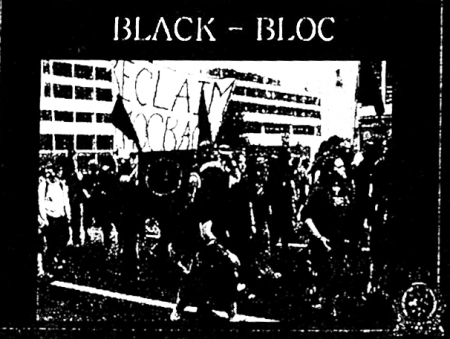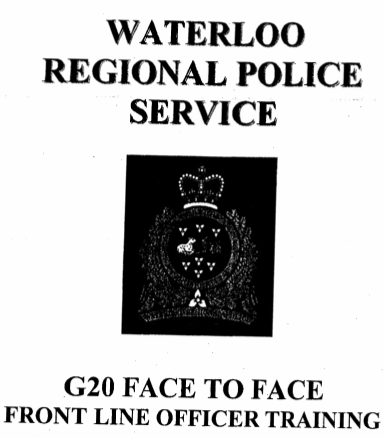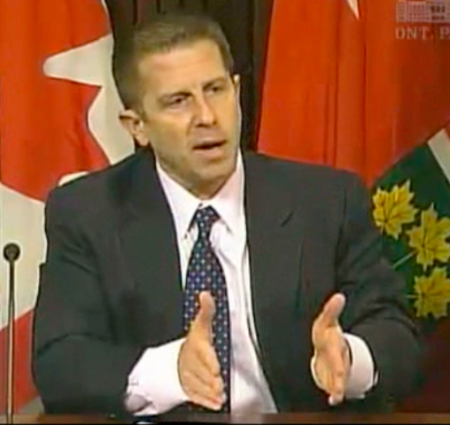Police trainers appear to have told officers at last June’s G20 summit in Toronto that special search and arrest powers extended far beyond the so-called five-metre zone the public was led to believe existed.
Officers were told the entire “outer zone” around the summit security fence, and not just a five-metre buffer, that was later revealed to be a sham, would be subject to special treatment under Ontario’s Public Works Protection Act (PWPA), according to a document released under freedom-of-information legislation and later provided to the Toronto Media Co-op by a group of Ontario researchers who have been investigating the G20.
The public was told shortly before the G20 that officers had special powers, but only within a 5-meter buffer around the fence separating G20 leaders from the public. The five-metre buffer was later revealed to be a sham.
Police were also instructed to treat young people and heavy knapsacks as suspicious, and told that medical emergencies and music were baiting tactics, the file reveals.
The 71-page document consists of PowerPoint slides and accompanying notes from a training session for Waterloo, Ont., police assigned to the G20. One slide explains that the downtown “OUTER ZONE will be designated a Public Work,” though there is no map in the file to specify what area that refers to.
However, all areas inside the G20 fence are accounted for by other zones listed on the same slide —suggesting that the “outer zone” refers either to a police traffic-control perimeter that extended several blocks beyond the fence, as far as King Street to the north, Spadina Avenue to the west and Yonge Street on the east, or even that it refers to anywhere else in Toronto.
In areas designated as “public works” police were empowered to arrest anyone who did not provide identification and submit to be searched.
“That is the suspension of civil liberties,” said Lelsey Wood, an activist and professor at York University who studies protest tactics.
Ontario government regulation 233/10 was quietly passed by cabinet on June 2, more than three weeks before the summit. It listed the G20 fence and areas within it as a public work, but the public was misled to believe that it extended to a five-metre buffer zone around the fence. The training-session slides suggest police were told their emergency powers stretched to the fence as well as an even bigger area.
‘Protesters vs. Anarchists’
The training document also sheds light on police tactics in areas well away from the fence. Several independent reports have decried those tactics as heavy-handed, and they have led to $161 million in lawsuits and more than 280 complaints to official police watchdogs.
One of the PowerPoint training-slides attempts to distinguish between legitimate protesters and “anarchists,” including members of the Black Bloc, who it says use “lawless action.” In accompanying notes, police are cautioned to be on the lookout for Black Bloc sympathizers, including musicians, people carrying medical supplies, cyclists and “young people (early teen to mid-twenties) who have injected themselves into the centre of the march.” It is also explained that “some, not all, Anarchists will dress in all black clothing or carry them in a bag to be used later on in the protest.”
“It's dangerous because it is based on stereotypes,” said Wood. “If police are working on faulty information like that, they are going be much more likely to police based on people's fashion choices than they are based on any sort of behaviour.”
Another slide lists noise as a baiting tactic. Musicians can “create sudden drives of energy and joy within the [Black] Bloc," which gives a "message of power to the enemy in battle," the accompanying notes read. "Black Bloc bagpipe players could bring immense joy to many, as does radical cheerleading to others."
Yet another set of notes instructs officers to be on the lookout for "an abnormally heavy knapsack or bag,” which “may be cause to suspect” that “rocks or other items to injury may be secretly inside."
Officers are informed that members of the black bloc will “have first aid equipment available.”
The document explains that "medical emergencies" can also be a "baiting tactic" and says they can be "real or staged."
“This is really dangerous misinformation that the police are being given,” Wood asserted. She explained that during the G20 “someone had a serious head injury and a medic, who is actually a trained nurse, was trying to get police assistance and police weren't believing her that she needed assistance and initially just completely dismissed it.”
A recent Canadian Medical Association Journal article on the same incident explained: “[A] pair of medics, surrounded by police, was trying to get help for a young man with a baton injury to the head. He was bleeding profusely and had a lowered level of consciousness. No one could get to them, including Emergency Medical Services.”
Caught in the Act
The training documents include five slides on the PWPA and a copy of the Act. The notes that accompany one of the slides say the “Purpose of the Act ... is to protect them againt terrorism,” but it is not clear who or what “them” refers to.
The police's use of the PWPA during the G20 became highly controversial.
“The effect of Regulation 233/10 ... was to infringe on freedom of expression in ways that do not seem justifiable in a free and democratic society,” reads a recent report by Ontario's ombudsman, André Marin, titled Caught in the Act. “The passage of the regulation triggered the extravagant police authority found in the Public Works Protection Act, including the power to arbitrarily arrest and detain people and to engage in unreasonable searches and seizures.”
The report claimns provisions of the act may be unconstitutional.
"There was a premeditated conscious planned decision not to announce the existence of the regulation or the reviving of this wartime act," Marin told a press conference when he released the report on December 7th. He explained that passing the regulation "would trigger what amounted to martial law in the streets of Toronto."
“The Ministry [of Community Safety and Correctional Services] simply handed over to the Toronto Police Service inordinate powers, without any efforts made to ensure those powers would not be misunderstood” the report reads.
Marin said that the "ground zero" for creating the regulation was in the office of Toronto Police Chief William Blair, and that the regulation was "sold to the province."
Not So Secret
The RCMP, Public Safety Canada and the OPP have all claimed they had no prior knowledge that a public works designation would be used, and full blame for the designation is being placed on Blair.
Marin also believed knowledge that regulation 233/10 had been introduced was a tightly kept secret, saying it was not shared with officers outside the Toronto Police Service until it was first used on Thursday, June 24, one day before the G20 Summit began.
"Apart from insiders in the government of Ontario, only members of the Toronto Police Service knew the rules of the game had changed," the Ombudsman's report says.
However, the training documents show that at least one police force other than the Toronto Police knew that a public works designation would be used. Although it never refers to Regulation 233/10 by name the training document makes clear a public works designation would be used.
“What we have seen through all the investigations around the policing of the G20 is as facts are revealed, admissions are made,” Wood said. “What we are going to see, I think, over the next few months is investigations showing that the RCMP, the OPP and even the Prime Minister's Office may have been far more aware of, and far more involved in, decisions around the policing of the G20 than they are currently admitting.”
Disclosure: The author of this article is a member of the group of Ontario researchers mentioned in the second paragraph. He was provided with the document by another member of that group.


